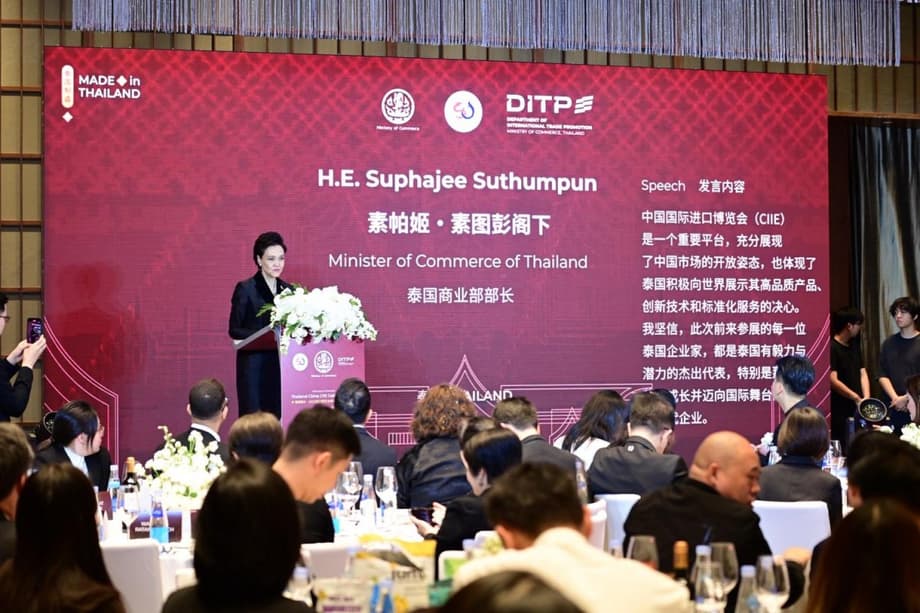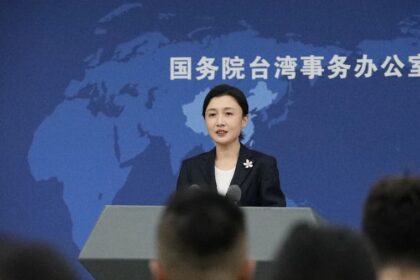Why Thailand is recasting its China strategy
Thailand is moving quickly to reshape how it engages the Chinese market after Beijing outlined a new national economic plan with a heavy focus on green growth, innovation, and higher incomes. Commerce Minister Suphajee Suthumpun has instructed Thailand’s nine trade offices in China to decode the priorities in China’s 15th National Economic and Social Development Plan and to build export strategies that match them. The directive arrived as China signaled plans to expand its middle income population from roughly 400 million to 800 million, a shift that could reshape demand in the world’s second largest consumer market.
- Why Thailand is recasting its China strategy
- What Beijing’s new plan means for Thai exporters
- Five product groups Thailand aims to scale in China
- Provincial strategies in China and market entry
- A persistent trade gap with China and what Thailand is doing
- Competing pressures from the US and Europe
- Logistics, rail corridors, and speed to market
- Free trade deals and the digital economy edge
- Risks and what businesses should watch
- Key Points
The message to Thai envoys is clear. Study the five year plan, identify products and services where Thailand can compete on quality and innovation, and work with Chinese partners to get them into the hands of consumers. The focus spans agricultural goods, consumer products, animal feed, health foods, and a growing roster of digital offerings including games and animation. The approach also aims to move beyond basic trade matching toward joint ventures that allow co development, local production, and faster approval in a market where regulations and consumer tastes vary by province.
China remains Thailand’s largest trading partner, and the opportunity is large. Thai fruit, processed food, wellness products, and creative content already have strong recognition among Chinese buyers. Thai officials want to turn that brand appeal into steady growth in higher value exports that align with China’s policy direction.
What Beijing’s new plan means for Thai exporters
China’s five year plans are detailed roadmaps that steer central and provincial spending, tax incentives, product standards, and market access rules. The latest plan gives prominence to green manufacturing, energy transition, advanced technology, and higher household consumption. Those themes match several Thai strengths, from premium agricultural produce and ready to eat foods to health and beauty products and digital content.
For food producers, the plan’s push for quality and safety elevates demand for traceable supply chains, certified farms, and reliable cold logistics. Thai exporters of rice, durian, mango, and mangosteen can benefit if they secure reliable season planning, rapid transit, and compliance with Chinese labeling and pesticide rules. Processed foods, condiments, and ready meals that showcase authentic Thai flavors can ride the trend toward premium convenience.
For consumer goods, the move to green consumption means packaging and materials matter. Biodegradable or recycled packaging, organic cosmetics, and natural home decor align with policy and consumer sentiment. In services and content, Beijing’s emphasis on indigenous innovation creates room for collaboration. Games, films, and animation can succeed through co production or licensing structures that meet local content rules while tapping Thai creative talent.
Five product groups Thailand aims to scale in China
Trade officers in Beijing, Hong Kong, Shanghai, Guangzhou, Qingdao, Xiamen, Chengdu, Kunming, and Nanning have identified five priority groups for expansion. Each group reflects changing tastes among Chinese consumers and aligns with policy themes in the new plan.
Agricultural and food
Thailand seeks to grow sales of rice and premium tropical fruits, along with processed and ready to eat foods and sauces. Success in this category hinges on dependable harvest quality, faster cold chain routing into inland cities, and smart branding to differentiate Thai origin from rival suppliers. Companies that lock in seasonal supply agreements and invest in shelf life testing can reduce waste and command higher prices. Geographical indication certification and food safety audits help win distributor trust on large platforms and in modern retail.
Pet and pet care
Urban pet ownership in China has expanded quickly, and owners are willing to pay for premium food and treatments. Thai producers of pet food and care items can compete on recipe quality, clear labeling, and stable ingredient sourcing. Partnerships with specialty retail chains and veterinarians, along with content marketing on social platforms, can build recognition faster than general online listings.
Health, wellness, and beauty
Bird’s nest products, plant protein, coconut water, spa items, and wellness services play to Thailand’s reputation for natural ingredients and hospitality. The key is to meet Chinese registration standards, document sourcing, and avoid exaggerated health claims. Beauty brands that align with clean beauty trends and invest in skin sensitivity testing gain an advantage. Wellness providers can explore joint ventures with Chinese operators to localize service menus and navigate licensing rules.
Eco friendly and sustainable goods
Biodegradable packaging, organic cosmetics, recycled clothing, natural home decor, and eco tourism are in demand as consumers look for lower impact choices. Demonstrating real sustainability is essential. Life cycle assessments, third party certifications, and QR based traceability reduce the risk of greenwashing complaints and improve placement on major retail platforms.
Innovation and digital content
Thai intellectual property in films, games, and animation is attracting interest from Chinese studios and platforms. Games still require approvals, and content rules are strict. Joint development with established Chinese publishers or co production deals with local studios can speed entry and reduce regulatory risk. Clear revenue sharing and intellectual property protection are critical for long term success.
Provincial strategies in China and market entry
China is a mosaic of provincial markets with distinct income levels, retail channels, and regulatory practices. A strategy that works in Guangdong may fail in Sichuan. Thai trade officers are being asked to map consumer preferences, retail partners, and local rules city by city, then guide Thai firms to the right channels and alliances.
Cross border ecommerce remains a fast route for market testing, especially through major platforms and specialty stores. Yet many categories, including cosmetics and some foods, benefit from general trade entry with full registration, which opens offline retail and reduces marketing hurdles. For high touch categories like wellness and beauty, partnerships with local distributors who can manage sampling, live commerce, and influencer campaigns drive better traction than a pure online approach.
In several sectors, Thai brands can shorten time to market by investing in joint ventures or contract manufacturing in China. Local production can meet content rules, simplify customs, and lower logistics costs while preserving Thai brand identity. Trade officers can also help firms prepare for inspections, lab testing, and digital compliance, including data rules for ecommerce operations.
Thailand’s network of trade offices in Beijing, Hong Kong, Shanghai, Guangzhou, Qingdao, Xiamen, Chengdu, Kunming, and Nanning serves as an on the ground bridge for product registration, distributor vetting, and provincial outreach. This is vital in a market where execution speed and regulatory accuracy often decide who wins shelf space.
A persistent trade gap with China and what Thailand is doing
The opportunity in China comes with a challenge. Thailand recorded a record trade deficit with China of about 19.23 billion dollars from January to April 2025, according to the Trade Policy and Strategy Office. Imports from China reached 31.56 billion dollars in the period, while exports totaled 12.33 billion dollars. Electronics and machinery dominated the import surge as companies stocked up on inputs amid uncertainty about global tariff changes.
In April 2025, imports from China hit 8.82 billion dollars in a single month while exports to China were 3.55 billion dollars. The import spike included electrical machinery and parts, general machinery, home appliances, and computers and related parts. These are the items manufacturers need when demand or policy shifts trigger a rush to secure components. At the same time, Thai fruit exports fell on weather issues, highlighting how agriculture faces supply constraints when conditions turn against growers.
Economists have warned that a rising share of exports come from pass through activity with little domestic value added. That limits job creation and weakens links between export numbers and factory output at home. The Commerce Ministry’s push for joint ventures, product upgrades, and better use of trade preferences aims to change that equation by anchoring more production, design, and services in Thailand.
Thai authorities are also weighing tools to support domestic producers facing intense competition from low priced imports. One option that has been discussed is a value added tax on small value imported parcels, which have grown quickly with online shopping. Careful design is needed to protect small firms without harming consumers or violating international rules.
External trade defenses also shape the landscape. The European Commission recently imposed anti dumping duties on epoxy resins from several sources, including Thailand. Anti dumping cases do not reflect a single product trend, but they signal that buyers in advanced economies are ready to use legal instruments when they see prices that they consider unfair. Thai exporters need to track cost structures, document market pricing, and be ready to cooperate with investigators if a case touches their sector.
Competing pressures from the US and Europe
Thai policy makers must manage the pull from China while navigating tougher stances from the United States and the European Union. New US tariffs have been applied to Thai goods, with some rates discussed as high as 36 percent. Thailand has formed a US Trade Policy Committee to negotiate tariff relief, review rules of origin, and work on regional value content. The government has also ordered studies on how potential US measures might affect electronics, agriculture, and other major export lines.
Brussels is reshaping trade defense practice, and it is also moving toward deeper digital and green standards in trade agreements. Thailand is working to conclude a free trade agreement with the European Union, a deal that would set stronger disciplines on services, investment, procurement, and sustainable production. That would bring benefits, but it will also raise the bar for regulatory compliance across many sectors.
Advanced economies are paying closer attention to goods that may be produced by Chinese firms operating in ASEAN or routed through the region. That places a premium on robust rules of origin, border documentation, and factory audits. Thai firms with ties to Chinese suppliers or investors should be ready to show origin, labor standards, and environmental practices to keep access to key markets.
Logistics, rail corridors, and speed to market
Faster, more reliable logistics can mean the difference between a product that thrives and one that misses its moment. Malaysia’s investment in the Perlis Inland Port near the Thai border and upgrades to rail links with Thailand aim to increase overland trade capacity between ASEAN and China. Thailand is double tracking the Hat Yai to Padang Besar rail line to boost freight capacity, while Malaysia is aligning inland rail with the East Coast Rail Link that will connect its east and west coasts and improve links to the Thai border.
These projects complement the China Laos Railway and new regional services such as the ASEAN Express from Selangor to Chongqing, which has demonstrated eight day deliveries across the China Laos Thailand Malaysia axis. Faster and more predictable rail routes reduce dependence on ocean lanes that face congestion or geopolitical risk. For Thai exporters of fresh fruit, chilled foods, electronics, and spare parts, expanded rail options create room to design supply chains around speed to inland Chinese cities.
Free trade deals and the digital economy edge
Thailand’s trade negotiators are pushing a wide slate of agreements that can expand market access and reduce costs for exporters. ASEAN has completed upgrades to the ASEAN China Free Trade Area and the ASEAN Trade in Goods Agreement. Thailand is also advancing talks with South Korea and the European Union and is part of the ASEAN Canada process. Several other agreements are moving through approval steps, including with Sri Lanka and the European Free Trade Association.
A major piece of the puzzle is the ASEAN Digital Economy Framework Agreement, which is targeted for completion in 2025. The pact aims to create common ground for issues like artificial intelligence, financial technology, cybersecurity, and anti fraud measures. That matters for Thai firms that sell digital products and services, move data across borders, or run ecommerce operations into China and beyond.
Free trade pacts work best when businesses know how to use them. The Commerce Ministry plans to boost outreach so exporters can take full advantage of lower tariffs, streamlined customs, and new rules that reduce red tape. With about 60 percent of Thailand’s trade already with FTA partners, faster use of digital certificates of origin and better understanding of product specific rules can save money and time.
Thailand is also building its digital capabilities at home. New industry events and business matching programs are showcasing software, cyber tools, ecommerce platforms, and artificial intelligence applications that can help firms upgrade production and marketing. As China places more emphasis on local innovation and secure technology, a stronger Thai digital ecosystem will be an asset for co development and cross border service exports.
Risks and what businesses should watch
Thai companies planning for China need to set clear milestones, budgets, and contingency plans. The China opportunity is real, but success requires discipline in compliance, quality, and marketing.
- Prove origin and compliance. Keep records for rules of origin, lab tests, and supplier audits. Prepare for buyer due diligence on environmental and labor practices.
- Back sustainability claims with data. Use certifications and track materials. Avoid vague language that could trigger complaints.
- Adapt to provincial differences. Tailor product lines and marketing to local tastes and price points in each city cluster.
- Invest in after sales service. Chinese consumers value fast support, easy returns, and reliable repair networks.
- Use multiple channels. Balance cross border ecommerce with distributor partnerships and offline retail where it fits.
- Manage currency and credit risks. Hedge if needed, and vet partners for payment reliability.
- Plan for trade shifts. Monitor tariff policy in the US and EU, and be ready to adjust sourcing and routing.
Key Points
- Thailand is aligning its China strategy with Beijing’s new plan focused on green growth, innovation, and higher incomes.
- Nine Thai trade offices in China have been tasked to build province specific plans and promote joint ventures.
- Five target groups are in focus: food and agriculture, pet care, health and beauty, eco friendly goods, and digital content.
- Thailand faces a large trade deficit with China as imports of machinery and electronics surge.
- US tariff risks and EU trade defenses are pushing Thailand to improve origin integrity and compliance.
- Rail and inland port projects in Thailand and Malaysia are expanding overland routes to inland Chinese cities.
- Upgrades to ASEAN China trade rules and a new regional digital economy pact could lower costs and expand access.
- Thai exporters are urged to document sustainability, tailor strategies by province, and diversify sales channels.












